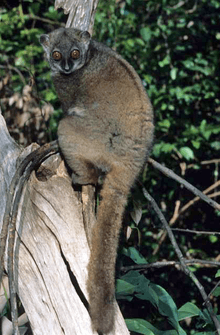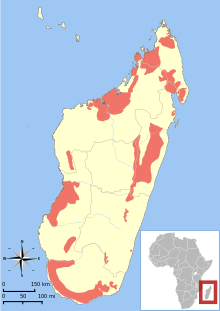Sportive lemur
| Sportive lemurs | |
|---|---|
 | |
| Sahamalaza sportive lemur (L. sahamalazensis) | |
| Conservation status | |
| Scientific classification | |
| Kingdom: | Animalia |
| Phylum: | Chordata |
| Class: | Mammalia |
| Order: | Primates |
| Suborder: | Strepsirrhini |
| Family: | Lepilemuridae Gray, 1870[2] |
| Genus: | Lepilemur I. Geoffroy, 1851[2] |
| Type species | |
| Lepilemur mustelinus I. Geoffroy | |
| Diversity | |
| About 26 species | |
 | |
| Combined distribution of Lepilemur[3] | |
| Synonyms | |
|
Genus:
| |
The sportive lemurs are the medium sized primates that make up the family Lepilemuridae. The family consists of only one extant genus, Lepilemur. They are closely related to the other lemurs and exclusively live on the island of Madagascar. For a time, this family was named Megaladapidae, but the current name was given precedence since the extinct genus Megaladapis was removed from the family.
Etymology
French zoologist Isidore Geoffroy Saint-Hilaire first described the genus Lepilemur in 1851, prefixing the existing genus Lemur with the Latin lepidus ("pleasant" or "pretty"). However, it was erroneously spelled—a mistake later authors unsuccessfully attempted to correct to Lepidolemur. Members of the monogeneric family Lepilemuridae are referred to as either sportive or weasel lemurs. "Sportive lemur", which is more commonly used, was coined by Henry Ogg Forbes in 1894. Though he did not explain the name choice, he did mention the agility of Lepilemur. "Weasel lemur" is an older common name, dating to the 1863 publication of Cassell's Popular National History. Dunkel et al. speculated that was inspired by the species name L. mustelinus, which means "weasel-like" in Latin.[4]
Physical characteristics
Their fur is grey brown or reddish colored on the top and whitish yellow underneath. They typically have a short head with large, round ears. They grow to a length of 30 to 35 cm (with a tail just about as long as their body) and weigh up to 0.9 kg. Their eyes have a tapetum lucidum behind the retina, hence they have eyeshine.
Behaviour and mating
Sportive lemurs are strictly nocturnal and predominantly arboreal, moving among the trees with long jumps powered by their strong hind legs. On the ground, they hop similarly to the kangaroo. During the day they hide in leafy covering or tree hollows. Sportive lemurs are solitary and defend their territory against same sex intruders. The territories of males and females can overlap.
Diet
They are mainly herbivores and their diet consists predominantly of leaves.
Reproduction and lifespan
Birthing happens between September and December after a gestation of 120 to 150 days, and is usually of a single young which is often reared in a nest in a tree hollow. At about four months the juveniles are weaned but remain with their mother up to an age of one year. At about 18 months they are fully mature, and live to be about eight years old.
Classification
- Family Lepilemuridae: sportive lemurs
- Genus Lepilemur
- AEECL's sportive lemur (Lepilemur aeeclis) *
- Ahmanson's sportive lemur (Lepilemur ahmansonorum) **
- Ankarana sportive lemur, (Lepilemur ankaranensis)
- Betsileo sportive lemur (Lepilemur betsileo) **
- Gray-backed sportive lemur, (Lepilemur dorsalis)
- Milne-Edwards' sportive lemur, (Lepilemur edwardsi)
- Fleurete's sportive lemur (Lepilemur fleuretae) **
- Grewcock's sportive lemur (Lepilemur grewcockorum) **
- Holland's sportive lemur (Lepilemur hollandorum) *****
- Hubbard's sportive lemur (Lepilemur hubbardorum) **
- James' sportive lemur (Lepilemur jamesorum) **
- White-footed sportive lemur, (Lepilemur leucopus)
- Small-toothed sportive lemur, (Lepilemur microdon)
- Daraina sportive lemur (Lepilemur milanoii) **
- Mittermeier's sportive lemur (Lepilemur mittermeieri)
- Weasel sportive lemur, (Lepilemur mustelinus)
- Otto's sportive lemur (Lepilemur otto) ***
- Petter's sportive lemur (Lepilemur petteri) **
- Randrianasolo's sportive lemur (Lepilemur randrianasoloi) *
- Red-tailed sportive lemur, (Lepilemur ruficaudatus)
- Sahamalaza sportive lemur (Lepilemur sahamalazensis) *
- Scott's sportive lemur (Lepilemur scottorum)****
- Seal's sportive lemur (Lepilemur seali) **
- Northern sportive lemur, (Lepilemur septentrionalis)
- Hawks' sportive lemur (Lepilemur tymerlachsoni) **
- Wright's sportive lemur (Lepilemur wrightae) **
- Genus Lepilemur
- * New species according to molecular analysis[5]
- ** New species according to molecular analysis[6]
- *** New species according to molecular analysis[7]
- **** New species according to molecular analysis[8]
- ***** New species according to molecular analysis[9]
References
- ↑ "Checklist of CITES Species". CITES. UNEP-WCMC. Retrieved 18 March 2015.
- ↑ 2.0 2.1 Groves, C. P. (2005). "Family Lepilemuridae". In Wilson, D. E.; Reeder, D. M. Mammal Species of the World (3rd ed.). Johns Hopkins University Press. pp. 117–119. ISBN 978-0-8018-8221-0. OCLC 62265494.
- ↑ "IUCN 2014". IUCN Red List of Threatened Species. Version 2014.3. International Union for Conservation of Nature. 2012. Retrieved 12 March 2015.
- ↑ Dunkel, A.R.; Zijlstra, J.S.; Groves, C.P. (2012). "Giant rabbits, marmosets, and British comedies: etymology of lemur names, part 1" (PDF). Lemur News 16: 64–70. ISSN 1608-1439.
- ↑ Andriaholinirina, N., Fausser, J., Roos, C., Rumpler, Y. et al. (2006-02-23). "Molecular phylogeny and taxonomic revision of the sportive lemurs (Lepilemur, Primates)". BMC Evolutionary Biology 6: 17. doi:10.1186/1471-2148-6-17. PMC 1397877. PMID 16504080.
- ↑ Louis, Jr., E.E.; Engberg, S.E.; Lei, R.; Geng, H.; Sommer, J.A.; Ramaromilanto, R.; Randriamanana, J.C.; Zaonarivelo, J.R.; Andriantompohavana, R.; Randria, G.; Prosper; Ramaromilanto, B.; Rakotoarisoa, G.; Rooney, A.; Brenneman, R.A. (2006). "Molecular and morphological analyses of the sportive lemurs (Family Megaladapidae: Genus Lepilemur) reveals 11 previously unrecognized species" (PDF). Texas Tech University Special Publications (49): 1–49.
- ↑ Mathias Craul, Elke Zimmermann, Solofo Rasoloharijaona, Blanchard Randrianambinina and Ute Radespiel (2007-05-31). "Unexpected species diversity of Malagasy primates (Lepilemur spp.) in the same biogeographical zone: a morphological and molecular approach with the description of two new species". BMC Evolutionary Biology 7: 83. doi:10.1186/1471-2148-7-83. PMC 1913500. PMID 17540016.
- ↑ Palmer, Jane (2008-02-21). "Henry Doorly Zoo scientists identify two new lemur species". Omaha World-Herald. Retrieved 2008-02-24.
- ↑ B. Ramaromilanto, R. Lei, S. E. Engberg, S. E. Johnson, B. D. Sitzmann, and E. E. Louis, Jr., 2009. (2009-04-08). "Description of a new sportive lemur, Holland’s or Mananara-Nord sportive lemur, from Mananara-Nord Biosphere Reserve, Madagascar". Museum of Texas Tech University, N. 286, 1-22. Retrieved 2009-05-23.
External links
| Wikispecies has information related to: Lepilemuridae |
| Wikispecies has information related to: Lepilemur |
- ARKive - images and movies of the northern sportive lemur (Lepilemur septentrionalis)
- New Lemurs
- Primate Info Net Lepilemur Factsheets
| ||||||||||||||